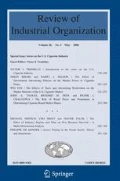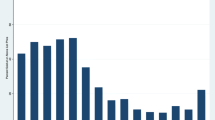Abstract
This paper explores entry and exit at a price comparison site (PCS) where the sunk costs of participation are effectively zero. We first use an unbalanced panel of 295 products on NexTag.com to estimate an error correction model of net entry. Although the results support our characterization of the PCS as a zero sunk cost market in which potential sellers behave as Kirznerian entrepreneurs in responding to opportunities, it is clear the net entry flow involves participants with widely differing behavior. This is investigated by examining exit and re-entry decisions at the seller level, which reveal that size and reputation determine individual responses to market opportunities.
Similar content being viewed by others
References
Baumol W. J., Panzar J. C., Willig R. D. (1982) Contestable markets and the theory of industry structure. Harcourt Brace Jovanovich, New York
Baye M., Gatti J. R., Kattuman P., Morgan J. (2007) A dashboard for on-line pricing. California Management Review 50(1): 202–216
Baye M., Gatti J. R., Kattuman P., Morgan J. (2009) Clicks, discontinuities and firm demand online. Journal of Economics & Management Strategy 18(4): 935–975
Baye M., Morgan J. (2001) Information gatekeepers on the internet and the competitiveness of homogeneous product markets. American Economic Review 91(3): 454–474
Baye M. R., Morgan J., Scholten P. (2004a) Price dispersion in the small and in the large: Evidence from a price comparison site. Journal of Industrial Economics 52(4): 463–496
Baye M. R., Morgan J., Scholten P. (2004b) Temporal price dispersion: Evidence from an on-line consumer electronics market. Journal of Interactive Marketing 18(4): 101–115
Baye M. R., Morgan J., Scholten P. (2006) Persistent price dispersion in on-line markets. In: Jansen D. (Ed.), The new economy and beyond. Edward Elgar, Northampton, MA
Brynjolfsson E., Dick A. A., Smith M. D. (2009) A nearly perfect market? Differentiation vs. price in consumer choice. Quantitative Marketing and Economics 8(1): 1–33
Caree M. A., Thurik A. R. (1999) The carrying capacity and entry and exit flows in retailing. International Journal of Industrial Organization 17(7): 985–1007
Clay K., Krishnan R., Wolff E. (2001) Prices and price dispersion on the web: Evidence from the online book industry. Journal of Industrial Economics 49(4): 521–539
Cotterill R. W., Haller L. E. (1992) Barrier and queue effects: A study of leading us supermarket chain entry patterns. Journal of Industrial Economics 40(4): 427–440
Fotopoulos G., Spence N. (1999) Net entry behavior in greek manufacturing: Consumer, intermediate and capital goods industries. International Journal of Industrial Organization 17(8): 1219–1230
Geroski P. (1991) Market dynamics and entry. Basil Blackwell, Oxford
Geroski P. (1995) What do we really know about entry?. International Journal of Industrial Organization 13(4): 421–440
Geroski P., Schwalbach J. (1991) Entry and market contestability: An international comparison. Basil Blackwell, Oxford
Haynes M., Thompson S. (2008) Price, price dispersion and number of sellers at a low entry cost shopbot. International Journal of Industrial Organization 26(2): 459–472
Igami M. (2011) Does big drive out small? Entry, exit and differentiation in the supermarket industry. Review of Industrial Organization 38(1): 1–21
Iyer G., Pazgal A. (2003) Internet shopping agents: Virtual co-location and competition. Marketing Science 22(1): 85–106
Kirzner I. M. (1973) Competition and entrepreneurship. University of Chicago Press, Chicago
Lin, Y.-C., & Scholten, P. (2005). Pricing behaviors of firms on the internet—Evidence from price comparison sites Cnet and NexTag. Bentley College working paper. http://www.nash-equilibrium.com/scholten/signaling.pdf.
Orr D. (1974) The determinants of entry: A study of canadian manufacturing industry. Review of Economics and Statistics 56(4): 58–66
Rosenthal R. W. (1980) A model in which an increase in the number of sellers leads to an increase in price. Econometrica 48(6): 1575–1580
Salop S., Stiglitz J. E. (1977) Bargains and ripoffs: a model of monopolistically competitive price dispersion. Review of Economic Studies 44(3): 493–510
Stigler G. (1961) The economics of information. Journal of Political Economy 69(3): 213–225
Stranger G., Greenstein S. (2008) Pricing in the shadow of firm turnover: ISPs during the 1990s. International Journal of Industrial Organization 26(3): 625–642
Thompson S. (2009) Grey power: An empirical investigation of the impact of parallel imports on market prices. Journal of Industry, Competition and Trade 9(3): 219–232
Varian H. (1980) A model of sales. American Economic Review 70(4): 651–659
Waldfogel J., Chen L. (2006) Does information undermine brand? Information intermediary use and preference for branded retailers. Journal of Industrial Economics 54(4): 425–450
Waterson M. (1981) On the definition and meaning of barriers to entry. Antitrust Bulletin 26: 521–539
Author information
Authors and Affiliations
Corresponding author
Rights and permissions
About this article
Cite this article
Haynes, M., Thompson, S. Entry and Exit Behavior in the Absence of Sunk Costs: Evidence from a Price Comparison Site. Rev Ind Organ 42, 1–23 (2013). https://doi.org/10.1007/s11151-012-9358-4
Published:
Issue Date:
DOI: https://doi.org/10.1007/s11151-012-9358-4




